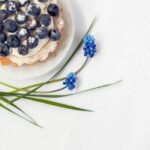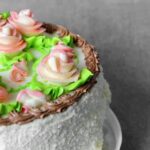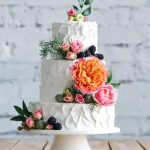Are you wondering what flowers to use for cake decorating? Flowers can add a touch of elegance and natural beauty to any cake, making it the perfect show-stopper for any occasion. Whether you prefer using fresh edible flowers or non-edible varieties, there are a multitude of options to choose from when it comes to floral cake decorations.
When it comes to cake decorating, flowers are a classic choice for adding a pop of color and enhancing the overall aesthetic. In this article, we will explore the different types of flowers that you can use to elevate your cake decorating game, from edible blooms to non-edible alternatives. We will also provide tips on proper preparation and placement, as well as creative flower alternatives for stunning cake designs.
With our comprehensive guide, you’ll be able to choose the perfect flowers for cake decorating that suit your style and preferences. Whether you’re a professional baker or an amateur enthusiast, there’s something in this article for everyone looking to explore the beauty of floral cake decorations.
Edible Flowers
Fresh flowers can add a touch of elegance and natural beauty to any cake. When it comes to using edible flowers for cake decorating, it’s important to choose blooms that are not only visually appealing but also safe for consumption. Here is a guide to using fresh flowers for cake decorating:
Choosing Edible Flowers
When selecting flowers to use on cakes, it’s crucial to ensure that they are edible and free from pesticides or other harmful chemicals. Some popular choices for edible flowers include roses, violets, pansies, lavender, and nasturtiums. These blooms not only add vibrant colors to your cakes but also offer a delicate floral flavor.
Preparation and Placement
Before using fresh flowers on a cake, it’s essential to properly prepare them. Remove the pistils, stamens, and any green parts from the flowers as they can be bitter or even toxic. Gently wash the petals with water and allow them to air dry before placing them on the cake. When placing fresh flowers on a cake, consider using a barrier such as parchment paper or flower spikes to prevent direct contact with the frosting.
Safety Considerations
While many flowers are indeed edible, it’s essential to exercise caution when using them for cake decorating. Not all flowers are safe for consumption, so it’s important to research each flower before using it on a cake. If in doubt about whether a particular flower is safe to eat, it’s best to err on the side of caution and opt for edible blooms that are commonly used in culinary applications.
By following these guidelines and being mindful of safety considerations when using fresh flowers for cake decorating, you can create stunning and delectable floral designs that elevate your cakes to new heights of beauty and flavor.
Non-Edible Flowers
When it comes to decorating cakes with flowers, it’s important to consider the safety of the flowers being used. While there are many beautiful and edible flowers that can be used to garnish cakes, not all flowers are safe for consumption. In this section, we will explore the best non-edible options for cake decorations that are both safe and beautiful.
Choosing Safe Non-Edible Flowers
When selecting non-edible flowers for cake decorating, it’s essential to choose varieties that are free from harmful chemicals or pesticides. It’s best to source flowers from a reputable florist or garden center, as these establishments will ensure that their flowers are safe for decorative use. Avoid using flowers from florists or nurseries that may have been treated with pesticides not intended for food consumption.
Popular Non-Edible Flowers for Cake Decorating
Some popular non-edible flower options for cake decorating include roses, tulips, carnations, orchids, and chrysanthemums. These flowers add a touch of elegance and beauty to any cake design without posing a risk to those enjoying the dessert. When using non-edible flowers on cakes, it’s important to carefully remove any stamens or pistils before placing them on the cake to avoid potential allergic reactions.
Best Practices for Using Non-Edible Flowers on Cakes
To ensure the safety of non-edible flowers used for cake decorating, it’s crucial to properly clean and prepare the blooms before placing them on the cake. It’s also essential to create a barrier between the flowers and the cake by using parchment paper or edible flower picks. By following these best practices, you can create stunning cake designs with non-edible flowers while ensuring the safety of those enjoying your delicious creations.
Popular Flowers for Cake Decorating
When it comes to choosing the perfect flowers for cake decorating, there are a few popular options that never fail to impress. Roses, peonies, and dahlias are just a few examples of blooms that can add a touch of elegance and beauty to any cake design. These flowers are not only visually stunning, but they also bring a delightful fragrance that can enhance the overall sensory experience of enjoying a slice of cake.
Roses are perhaps the most classic choice for cake decorating, as they symbolize love and romance. With their delicate petals and variety of colors, roses can be used to create both simple and intricate designs on cakes. Peonies, on the other hand, have a lush and full appearance that makes them perfect for adding a sense of abundance and opulence to cake decorations. Their soft pastel tones make them ideal for wedding cakes and other special occasions.
In addition to roses and peonies, there are many other popular flowers that can be used for cake decorating. From vibrant sunflowers to dainty lavender sprigs, each bloom brings its own unique charm to the table.
When selecting flowers for cake decorating, it’s important to consider not only their visual appeal but also their safety for consumption. It’s crucial to ensure that the flowers you choose are indeed edible and free from any pesticides or chemicals that could be harmful if ingested.
| Flower | Characteristics |
|---|---|
| Roses | Classic choice symbolizing love and romance; variety of colors; visually stunning |
| Peonies | Lush and full appearance; ideal for wedding cakes; soft pastel tones |
| Sunflowers | Vibrant; adds a pop of color; cheerful appearance |
Seasonal Flowers
When it comes to choosing the perfect flowers for cake decorating, considering the season can make a big difference in both availability and overall aesthetic. Different times of the year offer their own unique blooms that can elevate the look of any cake design. From bright and colorful flowers in the spring to rich and warm-toned blooms in the fall, there are endless options to choose from.
Spring
In the spring, you’ll find an abundance of beautiful flowers to use for cake decorating. Popular choices include peonies, tulips, daisies, and cherry blossoms. These flowers add a touch of whimsy and vibrancy to any cake design with their cheerful colors and delicate petals. They are perfect for celebrating weddings, birthdays, or any special occasion during this time of renewal and growth.
Summer
Summer brings about a plethora of bold and bright blooms that can be used for cake decoration. Sunflowers, dahlias, roses, and hydrangeas are popular choices during this season. Their vibrant colors and lush petals can instantly create a stunning focal point on any cake. Whether it’s a beach-themed wedding or a summer birthday celebration, these flowers are sure to make a statement.
Fall
As autumn sets in, deeper and richer colored blooms become popular choices for cake decorating. Dahlias, chrysanthemums, marigolds, and sunflowers are excellent options for adding warmth and depth to cakes during this season. Their earthy tones complement the cozy atmosphere of fall weddings, Thanksgiving celebrations, and other seasonal events.
Whether you’re looking to capture the essence of each season or simply want to work with what’s readily available at different times of the year, selecting seasonal flowers for cake decorating is a great way to enhance your designs while embracing nature’s natural beauty throughout the year.
Tips for Using Flowers on Cakes
When it comes to using flowers for cake decorating, proper preparation and placement are key to achieving a stunning and safe final result. Whether you are using fresh edible flowers or non-edible blooms for your cake design, it is important to follow certain guidelines to ensure that the flowers not only look beautiful but are also safe for consumption.
First and foremost, if you are opting for edible flowers, it is crucial to use only organic flowers that have been grown specifically for culinary use. Do not use flowers from florists or garden centers, as these may have been treated with pesticides or other chemicals that are not safe for consumption.
Popular options for edible flowers include roses, violets, pansies, and daisies. Before using them on your cake, thoroughly wash the flowers and remove any parts that are not edible.
For non-edible flowers used in cake decorating, such as roses and peonies, it is important to create a barrier between the blooms and the cake itself. This can be done by wrapping the stems of the flowers with floral tape or placing a small piece of parchment paper between the blooms and the cake. It’s also crucial to communicate with your clients about which parts of their cakes should be avoided when eating.
Placement of the flowers on the cake is equally important. When arranging fresh blooms on a cake, ensure that they are placed strategically and securely attached. For cascading floral designs, consider using flower spikes or floral picks to keep the blooms in place. Additionally, avoid placing flowers directly into frosting unless they have been inserted into food-safe flower picks first.
| Tips for Using Flowers on Cakes | Proper Preparation and Placement |
|---|---|
| If using edible flowers | Use organic flowers grown specifically for culinary use. |
| If using non-edible flowers | Create a barrier between the blooms and the cake. |
| Flower placement | Strategically place and securely attach fresh blooms on the cake. |
Flower Alternatives
When it comes to cake decorating, flowers are a classic and elegant choice. However, if you’re looking for something a little different or want to switch things up, there are plenty of creative alternatives to traditional floral decorations. Here are some unique options to consider when designing your next stunning cake:
- Fruit Decorations: Using fresh fruit like berries, citrus slices, or even edible flowers can add a pop of color and freshness to your cake. Consider arranging fruit in decorative patterns or cascading down the sides for a beautiful and delicious addition.
- Chocolate Accents: Whether it’s chocolate curls, shavings, or molded chocolate shapes, incorporating chocolate into your cake design can add a touch of indulgence and sophistication. From simple drizzles to intricate chocolate sculptures, the possibilities are endless.
- Metallic Details: Edible gold or silver leaf, metallic sprinkles, or even shimmer dust can bring a touch of glamour and luxury to your cake. Consider using these accents sparingly for a subtle yet striking effect.
Alternatively, you might want to explore more unconventional options such as incorporating edible pearls or even hand-painted designs on your cake. These unique alternatives can not only enhance the visual appeal of your creation but also add an unexpected element that will surely impress your guests.
Remember that when using any alternative decorations for cakes, it’s important to consider both flavor and texture. While some options may be purely decorative, others can add an extra layer of taste and complexity to your dessert. By exploring creative alternatives to traditional floral decorations, you’ll have the opportunity to push the boundaries of your cake decorating skills and create truly memorable designs.
Overall, whether you choose classic flowers or innovative alternatives for decorating your cakes, the key is to let your creativity shine through. Experimenting with different textures, colors, and flavors will help you elevate your cake decorating game and leave a lasting impression on anyone who takes a bite of your delicious creations.
Final Thoughts
In conclusion, when it comes to choosing the perfect flowers for cake decorating, the options are truly endless. Whether you opt for edible flowers, non-edible flowers, or even flower alternatives, there is a wide variety of blooms to choose from that can elevate your cake decorating game to the next level.
From classic roses and peonies to seasonal blooms that add a touch of freshness and color to your creations, the key is to consider not only the aesthetic appeal but also the safety and suitability of the flowers for consumption.
When deciding what flowers to use for cake decorating, always prioritize using organic and pesticide-free blooms whenever possible. This ensures that the flowers are safe for consumption and free from any harmful chemicals that could compromise the quality of your decorated cakes. Additionally, it’s important to properly prepare and place the flowers on your cakes, whether by washing them thoroughly or using floral picks to keep them securely in place.
Overall, incorporating flowers into your cake designs can add a touch of elegance and sophistication that will impress any crowd. Whether you’re creating a simple birthday cake or an elaborate wedding cake, carefully selected blooms can take your creations to the next level.
So don’t be afraid to explore different options and get creative with your choices – after all, what flowers to use for cake decorating is just as much about personal style as it is about visual appeal.

Welcome to my blog about home and family. This blog is a place where I will share my thoughts, ideas, and experiences related to these important topics. I am a stay-at-home mom with two young children. I hope you enjoy reading it! and may find some helpful tips and ideas that will make your home and family life even better!





